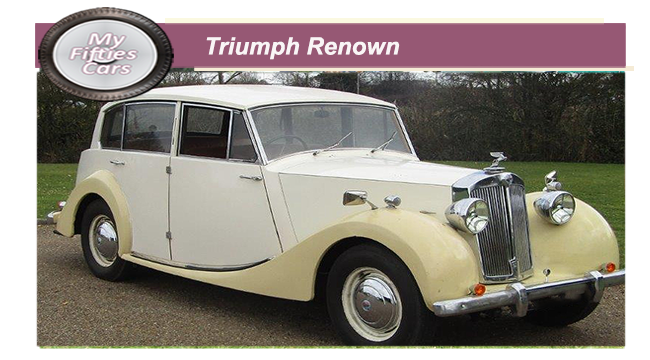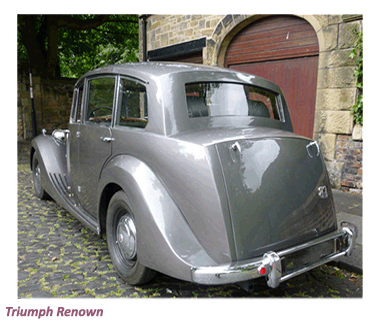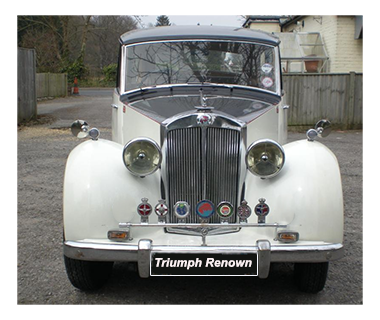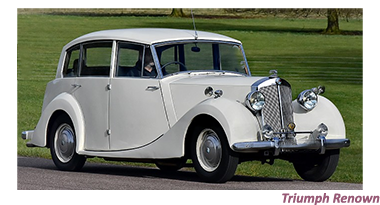
 In the days preceding the outbreak of Word War Two the Triumph Motor Company also foundthemselves fighting a battle- one which they lost with the company going into receivership.
In the days preceding the outbreak of Word War Two the Triumph Motor Company also foundthemselves fighting a battle- one which they lost with the company going into receivership.
The Triumph factory lay dormant for a number of years until it was tg having gone into acquired by the Standard Motor Company in 1944.
With demand for new motors cars on the rise company chairman Sir John Black was anxious to see the Triumph factory in Coventry get back into production.
 To make Black’s vision a reality, the Triumph design team literarily worked round the clock to design not one but two post-war Triumphs, both of which were launched early in 1946.
To make Black’s vision a reality, the Triumph design team literarily worked round the clock to design not one but two post-war Triumphs, both of which were launched early in 1946.
The first was a simple 2+2 open top, called the Roadster, while the other was a spacious family saloon, originally titled the Triumph 1800 although rapidly renamed the Renown.
![]()
 The first post-war Triumph saloon car had much in common mechanically with the company's sports models, as it was built around the same tubular chassis and fitted with an 1800 cc engine,
The first post-war Triumph saloon car had much in common mechanically with the company's sports models, as it was built around the same tubular chassis and fitted with an 1800 cc engine,
 In February of 1949, the Saloon received its first upgrade becoming known as the 2000 (Type TDA) and equipped with the 68bhp 2088cc Standard Vanguard engine matched to a three-speed gearbox and rear axle.
In February of 1949, the Saloon received its first upgrade becoming known as the 2000 (Type TDA) and equipped with the 68bhp 2088cc Standard Vanguard engine matched to a three-speed gearbox and rear axle.
This latest upgrade was offered to proved to be only temporary, and in October 1949 the 2000 eventually became the Renown.
 The Renown was fitted with an entirely different chassis, ostensibly a 108in-wheelbase version of the Standard Vanguard frame, with pressed box-section structural members, side members which swept up and over the rear axle and Vanguard-type coil spring independent front suspension.
The Renown was fitted with an entirely different chassis, ostensibly a 108in-wheelbase version of the Standard Vanguard frame, with pressed box-section structural members, side members which swept up and over the rear axle and Vanguard-type coil spring independent front suspension.
 Renowns had Vanguard-type instrumentation in a revised centre fascia.
In autumn 1951 Triumph introduced a smart limousine version of this body, with its wheelbase lengthened by three inches to provide more rear-seat legroom.
Displaying some deft engineering skills, the change was so subtly applied that it was difficult to spot the difference in body lines.
Renowns had Vanguard-type instrumentation in a revised centre fascia.
In autumn 1951 Triumph introduced a smart limousine version of this body, with its wheelbase lengthened by three inches to provide more rear-seat legroom.
Displaying some deft engineering skills, the change was so subtly applied that it was difficult to spot the difference in body lines.
![]()
Only 190 limousines were sold, but the same longer wheelbase and substantially altered body structure were applied to the saloons as well, becoming known as the TDC range.
 These were the last of the updates made to the Renown, which remained in production for another four years, finally been discontinued in October 1954.
The Triumph 1800/2000/Renown saloon had remained in production in one format or another for close to nine years.
These were the last of the updates made to the Renown, which remained in production for another four years, finally been discontinued in October 1954.
The Triumph 1800/2000/Renown saloon had remained in production in one format or another for close to nine years.
 Such was the Renown's impact, it took Triumph a number of years to come up with a direct replacement in the llarge scale saloon sector.
The replacement, when it came, was the Triumph 2000 which went on to become be a considerable commercial and success, possibly as a result of the lessons learned from the Renown.
Such was the Renown's impact, it took Triumph a number of years to come up with a direct replacement in the llarge scale saloon sector.
The replacement, when it came, was the Triumph 2000 which went on to become be a considerable commercial and success, possibly as a result of the lessons learned from the Renown.


